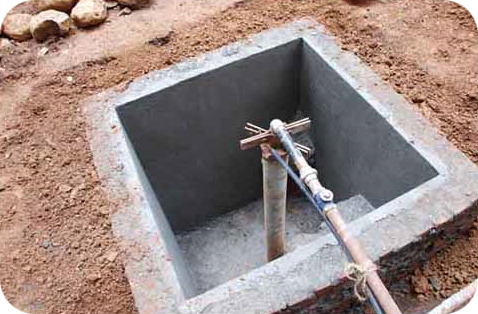Application: Aquifers, bore well, dug well, farms, reservoirs
Description: Recharge pits are small pits of any shape (rectangular, square or circular) constructed with brick or stone masonry walls with weep holes at regular intervals. It is located at the lowest point of a catchment, and rainwater flowing overland is directed into it. A casing pipe with small holes is covered with nylon mesh, before filling the filter material. The top of pit can be covered with perforated covers. The bottom of pit should be filled with filter material. The capacity of the pit can be designed on the basis of catchment area, rainfall intensity and recharge rate of the soil. Usually, the dimensions of the pit are 1-2 m wide and 2-3 m deep depending on the depth of pervious strata. The water passes through the filter material and clear water enters the bore well and recharges underground aquifers. These pits are suitable to recharge bore wells and shallow aquifers, increase soil moisture and for use by small households.
Contribution to climate resilience: Recharge pits allow rainwater to replenish groundwater, thus making use of heavier rainfall in the wet season and increasing the availability of water during the dry season (scenarios likely to become more severe with climate change). Because it is constructed using local labour and locally available materials, it can be repaired quickly, making it very resilient to both routine wear-and-tear and natural disasters.
Supplementary sources of information:
http://www.indiawaterportal.org/sites/indiawaterportal.org/files/WPRECHARGE2.pdf
http://theconstructor.org/water-resources/methods-of-rainwater-harvesting/5420/
http://www.wrmin.nic.in/writereaddata/ModelDesignsforRainWaterHarvesting.pdf
http://www.rainwaterharvestingindia.in/gallery.html
https://srds2020.wordpress.com/our-services/direct-bore-well-recharge/
Background image credit: https://www.thehindu.com/profile/photographers/SPECIAL-ARRANGEMENT/
This resilience-building measure is sourced from the Water Resource Adaptation Guide (2019) published by the National Council for Sustainable Development at the Ministry of Environment in Cambodia. The full Guide is available to download at URL https://ncsd.moe.gov.kh/sites/default/files/2019-10/Water%20Resources%20Adaptation%20Guide_March%202019_En.pdf


